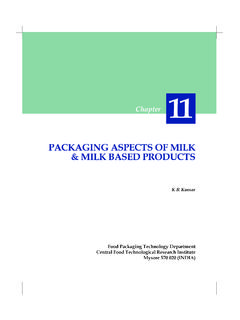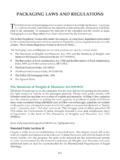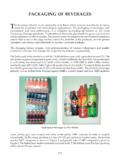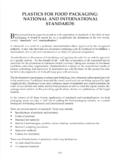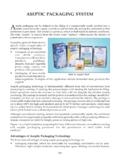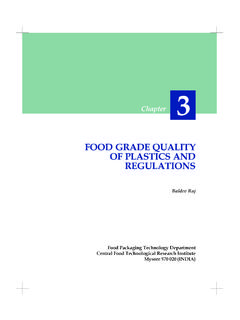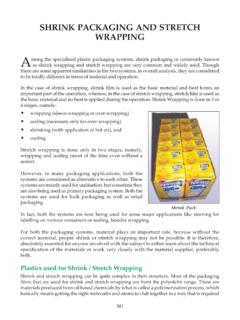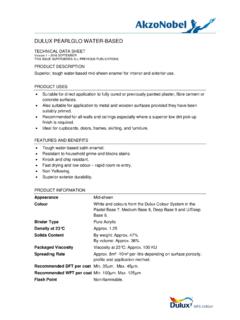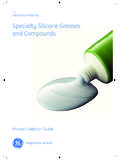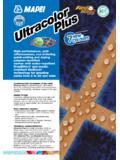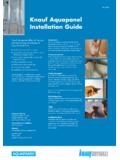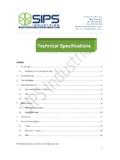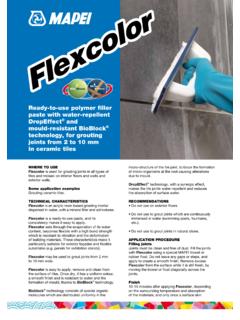Transcription of PACKAGING OF READY-TO-EAT/READY-TO- COOK …
1 151 PACKAGING OF READY-TO-EAT/READY-TO- COOK FOODC onvenience food is a concept that is prevalent in the developed world since long, while itsinception into the Indian market has been recent. With the changing socio-economic patternof life and the increasing number of working couples, the concept is fast becoming popular inIndian market. This type of food is becoming popular because it saves time and labour. Thisfood has extended shelf-life and is available off the market food products sector has been slow in penetrating the large potentialpresented by Indian 250 million strong middle class. But due to growing urbanisation andchanging food habits, the demand has been rising at a good pace and there is enough latentmarket potential waiting to be exploited through developmental convenience food could be basically classified into two categories: Shelf stable convenience food Frozen convenience foodShelf-stable convenience food are further classified as: ready -to-Eat (RTE) and ready -To-Serve (RTS) food - Idlis, dosas, pav bhaji, meatproducts like pre-cooked sausages, ham, chicken products, curries, chapattis, rice,vegetables like aloo chole, navratan kurma, channa masala etc.
2 ready -to-Cook food instant mixes like cake mixes, gulab-jamun mix, falooda mix, ice-cream mix, jelly mix, pudding mix etc., pasta products like noodles, macaroni, vermicelli Requirements of ready -to-Eat (RTE) and ready -to-Serve(RTS) FoodA ready -to-eat food product may be defined as any food product which does not require anyelaborate processing procedures on the part of consumer before it is good enough forExtruded ready -to-Cook Products Packed inPlastic PouchesReady-to-Cook/ ready -to-Eat Food inPlastic Pouches152consumption. It is ready -to-eat as soon as the pack is opened in a form, which is tasty advancements in food technology and PACKAGING technology have made it possible toextend the shelf-life of these products. Before deciding which PACKAGING material is to beused, it is necessary to know the PACKAGING requirements of the product what hazardswill cause product deterioration and the conditions to which the packagedproduct will be subjected throughout its shelf-life.
3 Some important packagingconsiderations, which influence the selection criteria for choosing PACKAGING materials,are highlighted. Product Characteristics The type of food and its composition, moisture, fat, protein, flavour etc. Form and shape of the product smooth, regular, irregular, with sharp edges etc. Nature of the product crisp, brittle, sticky etc. Factors Affecting PackagingFactors responsible for the spoilage of the food products: Biological spoilage due to micro-organisms Abiotic spoilage due to chemical reactions like oxidation, hydrolysis and enzymaticreactions. The environmental factors like light, humidity and temperature. The food processing parameters eg. processing temperature and duration. The shelf-life desired for a given ready -to-eat food, influences the type of PACKAGING andprocessing parameters to be snacks like idlis, dosas, pav bhaji etc. are sold across the counter and have a veryshort shelf-life, hence the PACKAGING requirements of these products are different from thoseof ready to eat products like curry rice, upma, vegetable biryani etc.
4 , which are retort processedfor longer like idlis, dosas, pizzas are packedin PACKAGING materials having low watervapour and oxygen permeability, odour andgrease resistance, and good physicalstrength. The PACKAGING materials generallyused are injection moulded plasticcontainers, plastic film/bag pouches orpaperboard normal practice, the ready -to-eat food areconsumed in a short span of time, but with theadvancement in PACKAGING technology, it isnow possible to produce these itemscommercially and to extend the shelf-life upto a few Products Packed in Retort Packs153 TABLE 1 Use of Various PACKAGING Laminates/CompositesMaterialPropertiesUs e9 mm foil / adhesive /Good moisture barrier,Over wraps confectioneriespaper coated with heatruns well on machinesealing vinyl resin9 mm foil / adhesive / paper /Good moisture barrier,Fin-sealed pouches andpolyethylene (extruded)runs well on machinesachets soups, in. polyethylene / 9 mm foil /Heat seals by the waxOver wraps foradhesive / paperbleeding through the tissue confectionery9 mm foil / adhesive / paper /Low WVTROver wraps for biscuits, comp.
5 /tissue (20 g/m2)FoilExcellent WVTR, goodCandy wrap, biscuit wrapmachinabilityCellophane / wad / cellophaneExcellent WVTR, sandwichBags or pouches forprinting, good machinehygroscopic itemsperformanceCellophane / adhesive /Excellent gas barrier,Nut packing with inert gaspliofilmtransparent packCellophane/polyethyleneExcellent gas barrier, trapped Chocolate, film / Saran coatedHigh strength, positive sealing Vacuum food PouchespolyethylenePolyester / adhesive / foil /Excellent gas barrier, goodFlexible processable cans polyethyleneheat resistance, good rigidity,aroma retention154 Indian food like palak paneer, dal fry, curry rice, upma, vegetables biryani etc. are retortprocessed hence their PACKAGING requirements are different. These products are retortprocessed because they are low acid food with moderate to large size particles; hence itis easy to remove oxygen from the head-space by gas flushing. The selection of a polymeror its combination is based on the requirement of barrier pouch is a special package in which the perishable food items are preserved byphysical, and/or chemical means.
6 It is a flexible laminate, which can withstandthermal processing, and combines the advantages of the metal can and the retort pouches are flexible packages made from multilayer plastic filmswith or without aluminium foil as one of the layers. Unlike the usual flexible packages,they are made of heat resistant plastics, thus making them suitable for processing inretort at a temperature of around 121 C. These retort pouches posses toughness andpuncture resistance normally required for any flexible PACKAGING . It can also withstandthe rigours of handling and distribution. The material is heat sealable and has goodbarrier India, 3-ply laminate consisting of PET/Al Foil/PP is commonly used for PACKAGING ofready to eat retort packed food. The product packed in such laminates has a shelf-life ofone year. The other materials generally used in retort pouch structure includes nylon,silica coated nylon, ethylene vinyl alcohol (EVOH) and polyvinyledene chloride (PVDC).These materials have high moisture barrier properties and are used successfully forpackaging of ready -to-eat high moisture Indian food.
7 Table 1 gives typical materials usedfor PACKAGING of various preformed pouches as well as pouchesformed on FFS machines are used. Preformedpouches are of flat and stand - up type. Thetypical structure of these pouches are:Flat configuration: 12 PET/12 Al foil/75 PPStand up configuration : 12 PET/9 Al foil/15 OPA/60 PPThe pouches are printed in attractive retort pouch is a space saving package byvalue of its design. It is a good substitute fortinplate cans as it eliminates the need for theaddition of brine in the conclusion, the market for retort pouchesis certainly one that will continue toexperience growth over the next few years, asthe retort pouch gets acceptable as equal to oreven superior to glass or metal containers. Thepouch has the same shelf-life as the can or theReady-to-Cook Products Packed in FlexiblePlastic Pouches155jar. The retort pouch needs to address ease of opening and re-closing (compared to glassjars). In addition, the PACKAGING economics of the pack for mass volume products will dependupon the ability to increase filling speeds and to move from batch to continuous , the retort pouch can save about 60% energy while processing.
8 Furthermore, as the productis already sterile, it does not require additional low temperature Requirements of ready -to-Cook (RTC) FoodBased on their initial moisture content, RTC food can be broadly classified as:Low Moisture Food Moisture 1 to 5% Equilibrium Relative Humidity(ERH) 18-20%These food have very low moisture andERH. Hence they have the tendency toabsorb moisture from the surroundingsand turn soggy, thereby, loosing theircrisp, brittle nature and taste. The mostimportant factor to be considered, ismoisture vapour transmission rate(MVTR) of the PACKAGING materialsused. MVTR values of less than 1 gm /m2 / 24 hours are Moisture Food Moisture 6 to 20% ERH up to 65% Typical examples: Indian savory snacks, sweetmeatsBarrier property (MVTR) requirement for these food is less stringent, however, for longershelf-life, microbiological spoilage has to be given due importance. Use of preservatives isoften Moisture Food Moisture 20 to 60% ERH up to 85% Typical examples:Freshly baked products bread, cake, chapatti,pickles, chutneys,sauces in Plastic PouchesPlastic Pouches for ready -to-Cook Food156 For freshly baked products such as bread, cake, ERH is often higher than the ambient the products tend to breathe out the moisture and if excess water vapour is not allowedto escape from the closed package, condensation on the outer surface of the product occurs,spoiling the product quality and leading to mould / yeast growth.
9 Plastic films such as lowdensity polyethylene (LDPE), which are permeable to water vapour are normally used forpackaging these products for shorter longer shelf-life, microbial spoilage is the main consideration. The products are sterilizedand packed in hermetically sealed containers such as cans, retort pouches or aseptic and high moisture food are very susceptible to the microbial spoilage and need adequateprocessing and preservation methods, prior to their /Air PermeabilityRTC food normally contain fat as well as other ingredients that can be oxidised. If oxygen/air is allowed to come in contact with the packaged food, oxidative degradation of fatoccurs, and many other oxidative changes take place, which cause rancidity, off flavourand discolouration in the food. Hence, PACKAGING material for high fat should have lowoxygen PermeabilityTo protect the food from oxygen/moisture, the food is usually packed in an inert atmosphereof Nitrogen ( N2 ). The N2 permeability of the package should be low to prevent its escape intothe Resistance PropertiesA variety of RTC food have edible oil and fat as their ingredients.
10 Fat/oil during storageshould not adversely affect the PACKAGING material used for these products, as fat may and LDPE are affected by fat and are not suitable for packing fatty products. Polyesterfilms, cellophane, polypropylene, inomer films etc. are suitable for such applications. If madein laminates, then the film offering excellent grease resistance is used as the innermost liner ofthe and essential oils contribute to the organoleptic qualities of many RTC food. They arevolatile substances and hence gas permeability of the PACKAGING material should be very lowto prevent flavour loss. This is also necessary to block the entry of the outside oxygen and air,which could bring out the oxidative changes in SensitivityLight accelerates oxidative changes associated with the flavours and fats in food. Opaquepackaging materials such as cans and aluminium foil offer best protection from polyester and pigmented plastics are found quite satisfactory. Light could causediscolouration in coloured food.
